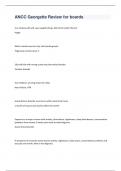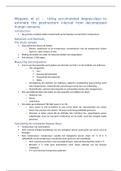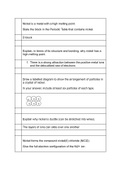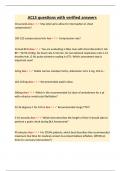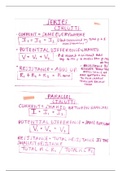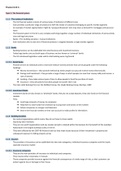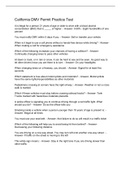Accounting
Lectures
Lecture 1 Chapter 1 & 2
Know the ratios at the end of each chapter
Accounting is important when making decisions based on financial facts -> know what
those financial facts are and how to come to know them.
Accounting is the information system that measures business activities, processes the
information into reports, and communicates the results to decision makers. -> Financial
accounting (external) and managerial accounting. (internal)
Generally accepted accounting principles (GAAP) (guidelines that govern accounting)
All in general info should be relevant; the info allows users to make a decision and
faithfully representative; the info is complete, neutral and free from material error
4 accounting assumptions;
-Economic entity assumption; assumes that every organization is a separate economic
unit
-Cost principle; all our assets should be recorded in the books
-Going concern assumption; that we know that the business will continue in the future
-Monetary unit assumption; all the transactions are recorded in a monetary unit, $ or
euro
Accounting equation; assets = liabilities + equity (must always be in balance)
Asset; everything that an organization owns
Liabilities; are debts that are owed to creditors
Equity; is the owner’s residual claim against the assets of the company (EV?) (owner’s
capital – owner’s withdrawals + revenues – expenses)
Transaction involves the exchange of economic resources (1) and we must be able to
measure the economic impact in monetary units. (2) (so euro or $)
Accounts receivable -> how much money we still need to receive from others (debits)
Accounts payable -> how much money we still need to pay to others (credits)
4 basic financial statements;
Income statement -> Net income; revenues – expenses reports success or failure
Statement of owner’s equity -> Owner’s equity; contribution + net income –
owner withdrawal (both net come and owner’s equity are about a certain period)
Balance sheet -> Balance sheet (assets and claims at a specific point in time);
assets, liabilities + owner’s equity
Statement of cash flows -> Cash flows; whether the business generates enough
cash to pay its bills. Cash flow from operating activities, cash flows from investing
activities, cash flows from financing activities
Chapter 2 Recording business transactions
Double entry bookkeeping; transactions always have two impacts on the
equation/balance -> help to keep the accounting equation in balance
1
,T account; is a shortened visual form of the more formal general ledger account format,
all increases on one side of the t-account and decreases on the other side.
Debit (DR) left, and Credit (CR) right. (debit or credit balance at the end of period)
Assets; increases -> debit, decreases -> credit
Liabilities; increases -> credit, decrease -> debit
Equity; increases -> credit, decreases debit
->>>> Expenses + ow. withdrawals; increases -> debit, decreases -> credit
->>>> Revenues + ow. Contribut.; increases; credit, decreases; debit
Debit first, then credit in the transaction scheme
Trial balance; gives you an overview of all the balances at the end of a period. Put all
the different smaller balances in one overview.
Name organization, type of sheet, date.
Most important things; record the transactions by creating journal and we do so by
making use of the accounting equation explained above. (1) and (2)
If we have done the transactions we can pose them to the T balance, then balance sheet
and you have the financial status. (+ credit and debit about t account)
Debt ratio: total liabilities ; total assets (x100%?)
Lecture 2 Chapter 3 & 4
For Making decisions we need financial information, therefore we journalize
Difference cash basis & accrual basis
Cash basis:
Revenue is recorded when cash is received
Expenses are recorded when cash is paid
Not allowed under GAAP
Accrual basis: (periodically analyse what are the revenues + expenses in a certain
period)
Revenue is recorded when it is earned
Expenses are recorded when incurred
Generally used by larger businesses
The time period concept; assumes that a business’ activities can be sliced into small
segments and that financial statements can be prepared for specific time periods, such
as a month etc. (any 12th month is referred to as a fiscal year)
The revenue recognition principle; Revenue should be recorded when it is earned!
-> A good has been delivered or a service has been performed, the earnings process is
complete, so when the transaction is there you note it, doesn’t depend on if you already
get paid or not yet.
The matching principle; expenses are matched at the end of the period against the
revenues for that period. (expenses are recorded when they’re incurred during the
period)
2
,Adjusting entry rules;
-Never involve cash
-Either increase revenue or increase an expense
-Accrued means amount must be recorded
Adjusting journal entries can be divided into two basic categories:
-Prepaids -> prepaid expenses (asset) + unearned revenues
-Accruals -> accrued revenues + accrued expenses
Depreciation: the process of systematically recording the periodic usage of plant assets
to generate revenues; accounts used are: depreciation expense, (hierop debit je de
afschrijving, dan op accumulated credit je het) accumulated depreciation. (contra
account on the asset side) (afschrijving) (land is never depreciated)
Book value: beginning value of the object – all the depreciations
Prepaid -> already paid but not all the services are provided yet
-> Debit rent expense, credit prepaid rent
Unearned revenue -> cash debit, unearned revenue credit (liability)
-> When we perform then debit unearned revenue, credit service revenue
Accrued expenses -> expenses that still need to be paid (salary e.g.) (liabilities)
-> Debit salaries expense, credit salaries payable
Accrued revenue -> we have done the transaction but we haven’t earned yet
-> Debit accounts receivable, credit service revenue
Adjusted trial balance -> includes accounts that didn’t appear on the original unadjusted
trial balance.
1. Enter the information from the unadjusted trial balance into the first two
columns of the worksheet
2. Enter the info for the adjusting journal entries into the adjustments columns
3
, 3. Cross-foot the numbers across the spread sheet to the adjusted trial balance
columns
Chapter 4
Adjusted trial balance -> make from here financial statements, such as income
instatement.
Current things first on balance sheet, then further long term things (classified balance
sheet)
-> Current; to receive within a year
-> Long term / plant assets are for a longer term, land & / long term payables etc.
Closing entries;
Close these;
Revenue accounts
Expense account
Withdrawal account
Not close these:
Asset accounts
Liability accounts
Capital account
At the end of each period must transfer the temporary account balances to the
permanent owner’s equity account. (to the income summary)
So then for example close revenue (credit) to income summary and credit it over there
Income summary debit; expenses, closed to capital, credit revenues + net income
Closed to capital will be used at the capital t account to add the net income or loss to the
beginning balance, which will together give you the ending balance.
Only balance sheet accounts are left after the closing entries are posted (prepare post-
closing trial balance)
Accounting cycle see pp
Current ratio: total current assets; total current liabilities (measures a company’s
ability to pay its current liabilities, rule of thumb strong current ratio is 1.5)
Debt ratio: total liabilities; total assets (measures business’s ability to pay its debts, rule
of thumb below 60% is considered safe) Indicates the proportion of a business’s assets
that are financed with debt
Recap:
Differentiate between cash basis accounting and accrual basis accounting
Define and apply the time period concept, revenue recognition and matching principles
Explain the purpose of and journalize and post adjusting entries
Explain the purpose of and prepare an adjusted trial balance
Identify the impact of adjusting entries on financial statements
4
Lectures
Lecture 1 Chapter 1 & 2
Know the ratios at the end of each chapter
Accounting is important when making decisions based on financial facts -> know what
those financial facts are and how to come to know them.
Accounting is the information system that measures business activities, processes the
information into reports, and communicates the results to decision makers. -> Financial
accounting (external) and managerial accounting. (internal)
Generally accepted accounting principles (GAAP) (guidelines that govern accounting)
All in general info should be relevant; the info allows users to make a decision and
faithfully representative; the info is complete, neutral and free from material error
4 accounting assumptions;
-Economic entity assumption; assumes that every organization is a separate economic
unit
-Cost principle; all our assets should be recorded in the books
-Going concern assumption; that we know that the business will continue in the future
-Monetary unit assumption; all the transactions are recorded in a monetary unit, $ or
euro
Accounting equation; assets = liabilities + equity (must always be in balance)
Asset; everything that an organization owns
Liabilities; are debts that are owed to creditors
Equity; is the owner’s residual claim against the assets of the company (EV?) (owner’s
capital – owner’s withdrawals + revenues – expenses)
Transaction involves the exchange of economic resources (1) and we must be able to
measure the economic impact in monetary units. (2) (so euro or $)
Accounts receivable -> how much money we still need to receive from others (debits)
Accounts payable -> how much money we still need to pay to others (credits)
4 basic financial statements;
Income statement -> Net income; revenues – expenses reports success or failure
Statement of owner’s equity -> Owner’s equity; contribution + net income –
owner withdrawal (both net come and owner’s equity are about a certain period)
Balance sheet -> Balance sheet (assets and claims at a specific point in time);
assets, liabilities + owner’s equity
Statement of cash flows -> Cash flows; whether the business generates enough
cash to pay its bills. Cash flow from operating activities, cash flows from investing
activities, cash flows from financing activities
Chapter 2 Recording business transactions
Double entry bookkeeping; transactions always have two impacts on the
equation/balance -> help to keep the accounting equation in balance
1
,T account; is a shortened visual form of the more formal general ledger account format,
all increases on one side of the t-account and decreases on the other side.
Debit (DR) left, and Credit (CR) right. (debit or credit balance at the end of period)
Assets; increases -> debit, decreases -> credit
Liabilities; increases -> credit, decrease -> debit
Equity; increases -> credit, decreases debit
->>>> Expenses + ow. withdrawals; increases -> debit, decreases -> credit
->>>> Revenues + ow. Contribut.; increases; credit, decreases; debit
Debit first, then credit in the transaction scheme
Trial balance; gives you an overview of all the balances at the end of a period. Put all
the different smaller balances in one overview.
Name organization, type of sheet, date.
Most important things; record the transactions by creating journal and we do so by
making use of the accounting equation explained above. (1) and (2)
If we have done the transactions we can pose them to the T balance, then balance sheet
and you have the financial status. (+ credit and debit about t account)
Debt ratio: total liabilities ; total assets (x100%?)
Lecture 2 Chapter 3 & 4
For Making decisions we need financial information, therefore we journalize
Difference cash basis & accrual basis
Cash basis:
Revenue is recorded when cash is received
Expenses are recorded when cash is paid
Not allowed under GAAP
Accrual basis: (periodically analyse what are the revenues + expenses in a certain
period)
Revenue is recorded when it is earned
Expenses are recorded when incurred
Generally used by larger businesses
The time period concept; assumes that a business’ activities can be sliced into small
segments and that financial statements can be prepared for specific time periods, such
as a month etc. (any 12th month is referred to as a fiscal year)
The revenue recognition principle; Revenue should be recorded when it is earned!
-> A good has been delivered or a service has been performed, the earnings process is
complete, so when the transaction is there you note it, doesn’t depend on if you already
get paid or not yet.
The matching principle; expenses are matched at the end of the period against the
revenues for that period. (expenses are recorded when they’re incurred during the
period)
2
,Adjusting entry rules;
-Never involve cash
-Either increase revenue or increase an expense
-Accrued means amount must be recorded
Adjusting journal entries can be divided into two basic categories:
-Prepaids -> prepaid expenses (asset) + unearned revenues
-Accruals -> accrued revenues + accrued expenses
Depreciation: the process of systematically recording the periodic usage of plant assets
to generate revenues; accounts used are: depreciation expense, (hierop debit je de
afschrijving, dan op accumulated credit je het) accumulated depreciation. (contra
account on the asset side) (afschrijving) (land is never depreciated)
Book value: beginning value of the object – all the depreciations
Prepaid -> already paid but not all the services are provided yet
-> Debit rent expense, credit prepaid rent
Unearned revenue -> cash debit, unearned revenue credit (liability)
-> When we perform then debit unearned revenue, credit service revenue
Accrued expenses -> expenses that still need to be paid (salary e.g.) (liabilities)
-> Debit salaries expense, credit salaries payable
Accrued revenue -> we have done the transaction but we haven’t earned yet
-> Debit accounts receivable, credit service revenue
Adjusted trial balance -> includes accounts that didn’t appear on the original unadjusted
trial balance.
1. Enter the information from the unadjusted trial balance into the first two
columns of the worksheet
2. Enter the info for the adjusting journal entries into the adjustments columns
3
, 3. Cross-foot the numbers across the spread sheet to the adjusted trial balance
columns
Chapter 4
Adjusted trial balance -> make from here financial statements, such as income
instatement.
Current things first on balance sheet, then further long term things (classified balance
sheet)
-> Current; to receive within a year
-> Long term / plant assets are for a longer term, land & / long term payables etc.
Closing entries;
Close these;
Revenue accounts
Expense account
Withdrawal account
Not close these:
Asset accounts
Liability accounts
Capital account
At the end of each period must transfer the temporary account balances to the
permanent owner’s equity account. (to the income summary)
So then for example close revenue (credit) to income summary and credit it over there
Income summary debit; expenses, closed to capital, credit revenues + net income
Closed to capital will be used at the capital t account to add the net income or loss to the
beginning balance, which will together give you the ending balance.
Only balance sheet accounts are left after the closing entries are posted (prepare post-
closing trial balance)
Accounting cycle see pp
Current ratio: total current assets; total current liabilities (measures a company’s
ability to pay its current liabilities, rule of thumb strong current ratio is 1.5)
Debt ratio: total liabilities; total assets (measures business’s ability to pay its debts, rule
of thumb below 60% is considered safe) Indicates the proportion of a business’s assets
that are financed with debt
Recap:
Differentiate between cash basis accounting and accrual basis accounting
Define and apply the time period concept, revenue recognition and matching principles
Explain the purpose of and journalize and post adjusting entries
Explain the purpose of and prepare an adjusted trial balance
Identify the impact of adjusting entries on financial statements
4



